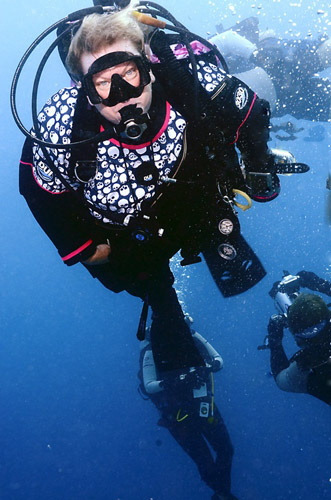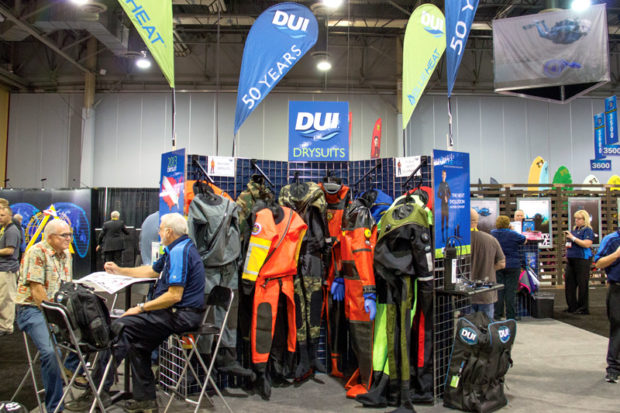Designing for Women: An industry pro talks shop and shape
DUI President Susan Long offers a perspective on the challenges of dive garment fit from the perspective of a woman and a manufacturer.
Make it smaller and make it pink. Not so long ago that was the fallback position for most manufacturers when designing dive equipment for women. It wasn’t that manufacturers thought women divers were second-class citizens or that they didn’t deserve properly fitting gear. It was simply a matter of numbers. Until ladies got out and dived more, it didn’t make sense to spend a lot of time and money in R&D for such a small segment of the market.
Don’t get me wrong. I’m a diver and I’m female. My money is as good as any man’s and I want equipment that fits ‘me’. And the more money I spend, the higher are my expectations. But I’m also a diving equipment manufacturer and I’ve seen it from the other side of the size chart. How do you meet customers’ expectations while watching the bottom line? While I’m not claiming to be an expert in all aspects of diving equipment, I do happen to be president of one of the most highly respected drysuit companies in the world. So, perhaps I can shed a little light on why manufactures do what they do.

One Size Fits Nobody
First off ladies, let’s face it, there aren’t that many of us. Sure, our numbers in general certifications are growing as a percentage ever so slowly, but as a group we’re still well behind male diver totals. And in advanced certifications, female numbers really drop off. Why is that? Some of the best divers I have ever met are women. They are more in tune with their bodies, with their equipment and with the aquatic environment. They don’t see themselves as “you ocean, me Jane.” Instead, women see diving as an opportunity to be part of the environment, part of the experience. The water they are diving in isn’t something to conquer, it’s something to become a part of.
Another issue that faces manufacturers is the fact that women come in all shapes and sizes. Men are pretty basic animals (and I’m talking about size here). Eighty per cent of them can be put into the categories of medium, large and extra-large. But women range from the very small to the very tall. Then add all of the variations like big bust, small bust, long legs, short legs, wide hips, narrow hips, slim waist, no waist, long torso, short torso … and every combination of these you can think of. One size fits nobody. And to top it off, we all have different size feet. So, not only are there fewer women divers but it’s necessary to break down our numbers further into sub-categories of sizes. So, from the manufacturer’s standpoint, who do you fit and who do you decide you can’t afford to fit?
Let me explain that last statement. Take a size large man, for example. You make a pattern and end up making 1,000 suits from it so the expense can be amortized over 1,000 suits. Now consider a pattern that requires just as much R&D time to create, maybe more, because it’s not a pattern you use very often (if you don’t make suits from it as often, you’re not quite as proficient and it takes longer). Divide that pattern cost by the number of suits made and the result is obvious: it costs a lot more.
What is Size Medium?
Here’s something you might find interesting. What is a size medium, or any other size for that matter? It’s whatever that manufacturer says it is. Think about the last time you bought a pair of jeans. You could probably fit in three different sizes. Maybe even from the same label. And, if you found a pair that you liked so much that you wanted to buy two, you still have to try them on because even then, given manufacturing tolerance levels, they can fit differently. We’ve all come to realize this in the dressing room. And did I mention vanity sizing? Just so you know, men like this part, too. The smaller the size, the happier the consumer, it’s just human nature.
All of that said our position at DUI has always been that women are divers, too. Sure, women pay more for haircuts and jeans, but they shouldn’t have to pay more for a drysuit. And at DUI that’s been the case even before women assumed responsibilities as company president, vice president of sales, production manager and assistant production manager. And that’s because it was our father’s belief when he founded the company in 1963. You might think having four daughters influenced this point of view, but it’s because he’s always believed diving should be as accessible to as many people as possible.
When it comes to diving equipment, ladies, you have to try it on. You have to see how it fits ‘you’. Don’t accept another person’s word for it. Fit is personal. Take jeans for example. Just look around, some wear them almost skin tight, others to the point of almost falling off. Yet to all of these people, their jeans ‘fit’.’ You have to try them on. And this reality is even more important with dive gear.
When you try on a BC, for example, what else will you be wearing? Just a dive skin? Maybe a wetsuit. If so, is it 3mm, 5mm or 7mm? Or must the BC fit over a drysuit? Whatever the case, it must accommodate the type of exposure protection you’ll wear underneath? Be sure it affords full freedom of movement. Deflated and inflated! Ensure you can move freely. Restrictions can create anxiety. If you can’t move properly, even if it’s just a little restrictive, move on, find another unit. Also consider weight integration. If this feature is offered, will it hold all the weight needed for the coldest water you’ll dive? Fully loaded with that weight can you comfortably pick it up? And is the weight positioned well affording good trim in the water? What else? Can you reach all the pockets when it’s worn over your exposure suit? With mask on can you find the D-rings to attach a light or detach it? Ask yourself if you’re ever going to wear the BC without exposure garment protection. If the answer is no, then you don’t need the fuzzy padding. Your skin is never going to touch it. It’s for hanger-appeal only.
Bottom line, grab your female friends and get out there and dive. Don’t wait for that Caribbean vacation either. There are so many incredible adventures and experiences to be had in our local waters. Sure it takes a little more equipment, but remember when you first learned to dive? It was new and, to be honest, a little scary too. But you overcame that step by step. My Dad says that diving is five per cent skill and 95 per cent practice. It’s all about getting out there and doing it. The underwater world is out there waiting for you and what I’ve found is that when you start to noticing all the little things, you discover they’re all around you. And in my opinion nobody is more in tune with the ability to appreciate what the underwater world has to offer than a woman: we don’t just see it, we feel it. We’re part of it. And in this crazy wound-up world we live in, it’s a way to unwind and become part of something bigger than ourselves.
So get out there. Dive. And have fun. That is what it is all about.
For more on DUI visit: www.dui-online.com
Leave a Comment










